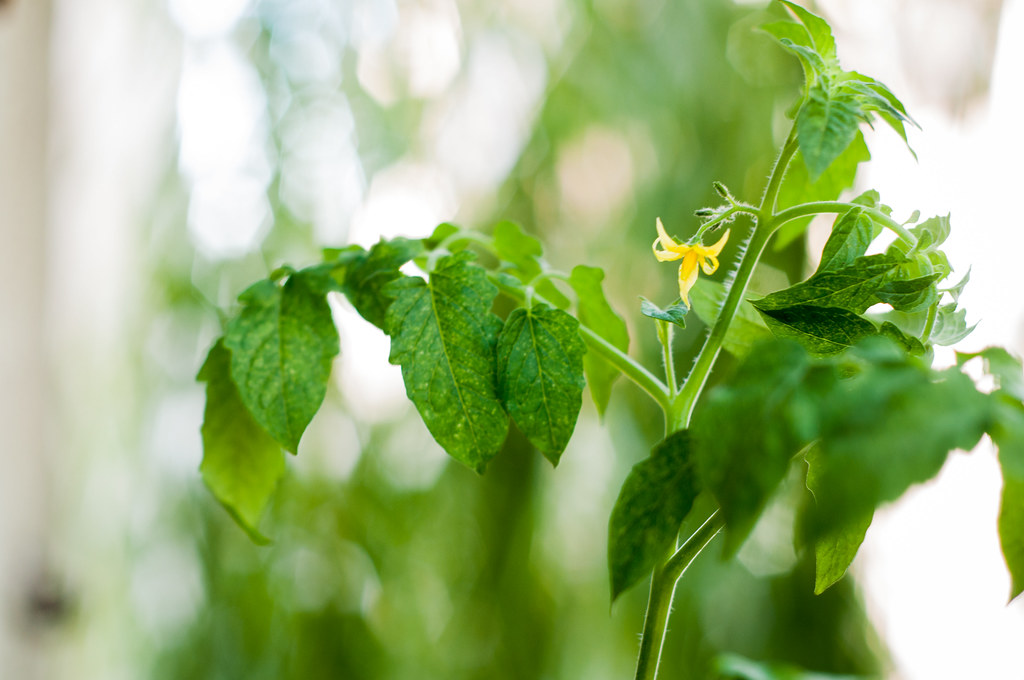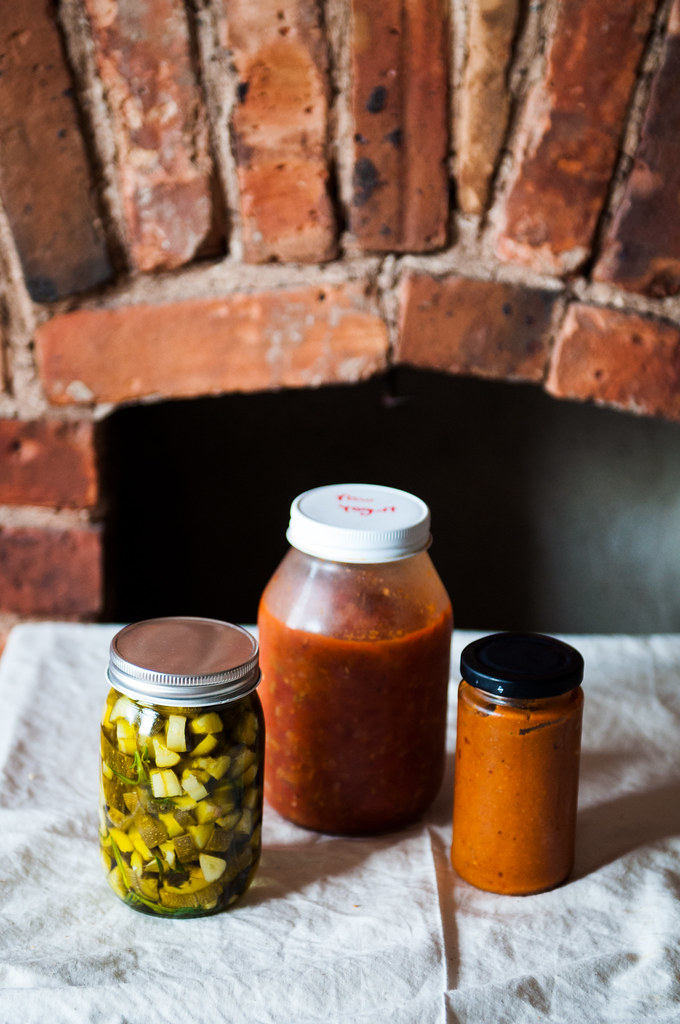
This year I have been playing country girl a little more than usual. I am immensely aided in that script by the easy access to props via the farmers' market that happens across the street every week! As Summer rolled along, I was confronted with bounties of vegetables, unsprayed and
naturally
(non-certified organic) grown. Often, I simply could not resist picking up more than I wanted. Many times, it was a deliberate attempt.
I remember the week I decided I wanted to preserve strawberries for the cooler weather. The farm from which I had been buying the whole season was doing something really good because the berries were small, luscious and incredibly sweet. I barely managed to save a few from straight from the container consumption. That weekend for no odd reason, I decided to pick up three pints for the astronomical price of $10 for all. I balked at the price but something told me to anyway. Back home, I separated the needs-to-be-consumed-asap and can-be-frozen, pinched off the leaves, packed them in freezer bags and felt rather content. The next Sunday, I picked my way to this farm first and lo and behold, I beheld the truth of my intuition. What last week was perfectly plump and succulent was now past the prime! What a difference a week makes. The berries were doubtless tasty but they were surely past their best date. That was end of strawberry season but I was super kicked that my sixth sense had led to me saving some to savor in the cold cold months of Winter. Obviously, the warmth of my victory would be as welcome as the preserved taste of Summer.


Since that insightful incident, I have learnt to listen to that inner country girl voice of mine. I pick up extra quantities when it tells me to. It helps me pick the ripest tomatoes and crispest squash and beans, so I can pickle, sauté and preserve for eternal uses. This was my first time with beans and I used a basic vinegar pickling recipe, I share below. I tried both white and green beans and I have to say, I preferred the white ones. They held up better and were a touch sweeter. You can use the same pickling base for any other vegetable like cauliflower, carrot, beets etc. On that note, has anyone pickled potato? I have a strong itch to but having never heard of it, I am wondering if I should just take the leap...Or well, am I missing something obvious?
That said, I think if you haven't done any pickling or preserving before, now is about a good enough time for it. There are still Summer produce in the market. I think we are fairly able to desist from simply stuffing our faces with it and calmly step away and think about holding on for later. You know, moving to delayed gratification that can be sometimes so much sweeter. Digressing a bit on the related topic, btw, have you heard of
? Rather fascinating!

We all make tomato sauce which often graces pizzas, pastas and such. I make a ton of it usually. This year, I made tomato paste. Trust you me, it was eye-opening. The intense tomato-ness was perfectly encapsulated in each bite. It was all I could do to not simply stick my finger in and lick! It is brilliant as a curry base, as a spread on toast and even on pizza. And, best of all it has a long long shelf life because you cook all the water out of it leaving a caramely preserve. Simply amazing. Make it once and then you stick your nose up at all those store ones.
Then there were cherries, pickled in brandy and reserved for Old Fashioneds and the odd dour day, when popping a few thoughtfully into your mouth is just the thing to perk you up. The trick here is to be rather generous with brandy. I will share this recipe in another post.

Finally, my ever favorite that I make each year.
. I loved it the first time I made it and fall in love, every time. The good thing about the oil is that you don't need to store it in a fridge and when you have used up the pickle and have oil remaining, you can use it to cook with or dress salads. The infused flavors add a lovely hint to a salad.
Oh while we are talking about all these plants, I thought I'll give you an update on the garden (read how I started in this
). Essentially, I got 2 cherry tomatoes from 4 tomato plants that I had on my fire escape landing. Bummer! Yes! I don't quite get this whole urban gardening thing. It worked great for herbs I have to say. But for produce plants, I have realized for all the resources I poured into it, soil, water and my TLC, I could have spent it better at the farmers' market. Not to mention the frustration and disappointment of not getting a garden bounty!
What do you think? Do you think trying to grow vegetables on a windowsill is a good idea? Have you done it and been successful?
One Year Ago:
Tomatillo, Swiss Chard and Jalapeno Quiche
Two Years Ago:
Three Years Ago:
Four Years Ago:
Five Years Ago:
{I will be making this soon enough now!}
Easy Vegetable Pickles
Quantities are approximate but ratios are important. Always use vinegar to water in 4:3 ratio. That means 4 cups vinegar to 3 cups water.
This pickling liquid works well with most vegetables beans, cucumbers, carrots, cauliflower, broccoli etc.
2 cups white vinegar
1-1/2 cups water
2 T whole coriander seeds
2 T cumin seeds
1 T chilli flakes (optional)
3 T salt
3 T sugar
vegetables you want to pickle and appropriate size jars
In a heavy bottomed vessel, toast the seeds until fragrant. Add the rest of the ingredients and bring to a boil. Reduce the heat and simmer for 2 minutes. Meanwhile, pack the cut raw vegetables in jars leaving an inch head room from the mouth.
Pour the hot pickling liquid over the vegetables until fully covered and a half inch head room from the mouth and lid.
Leave to sit at room temperature for atleast 48 hours before consuming.
Once opened store in refrigerator. It says for ages in the fridge but cannot be frozen.
Basic Tomato Paste
(makes one small jar)
This is basic vegetarian recipe and has the longest shelf life. You can use duck or goose fat or lard to cook the tomatoes in for added flavor. You can also use chopped piece of bacon. Adding the animal component will add incredible flavor but will also shorten the life of the preserve. So, if you make the meatier version, I would recommend small batches.
4 ripe non-pesticide, no-spray tomatoes, chopped fine
1 small red onion
3 cloves of garlic
2 sprigs of rosemary
1 tsp chilli flakes
salt, pepper and olive oil as needed
In a heavy pan, pour oil to cover the base of the pan. Sauté the onion and garlic until soft.
Add salt and pepper and continue cooking. Add the tomatoes and chili flakes and bring to a boil.
Now comes the best part. Put the lid on, turn the heat to the lowest setting and let it go for a couple of hours until the water has all gone away and you can brown sticky edges on the pan.
Scrape the reduced sauce into a blender and puree to smooth paste.
Transfer to a cleansed and sterilised canning or jam jar and seal with heat. Let it cool to temperature and store in the fridge once opened.
